I spoke at Experience Bucharest conference! Travel influencers Romania tourism event, Bellu Cemetery vampire fashion.
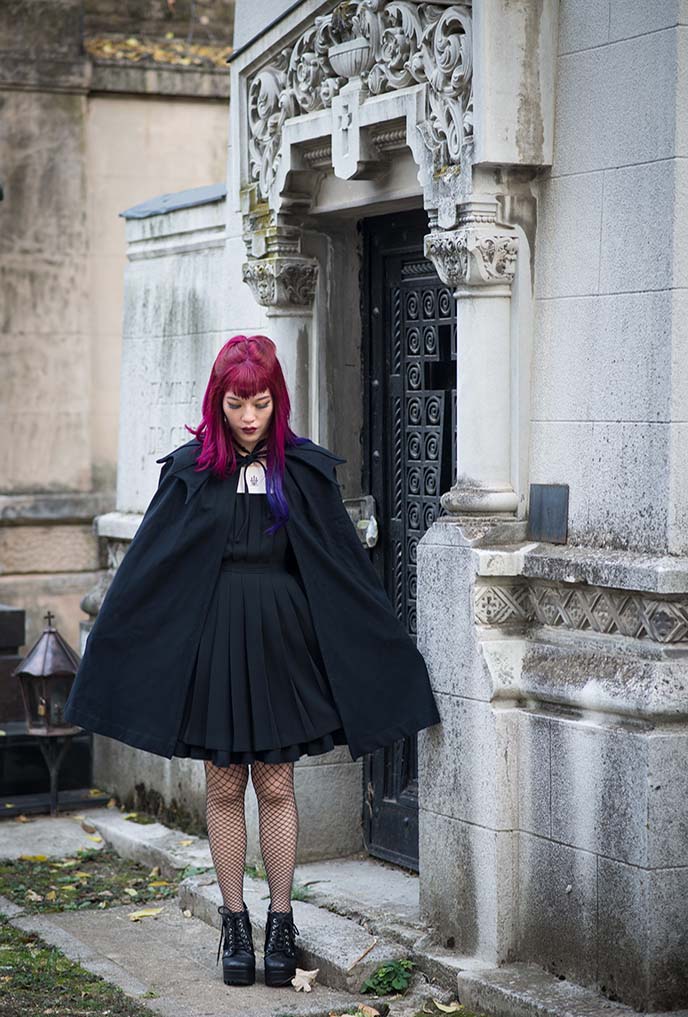
This little vampire had the best Halloween ever. I got to visit the ultimate Gothic destination… Bucharest, Romania!
Since I was a teen, I imagined myself haunting Romania’s cemeteries. This dream became reality, thanks to the hard-working team at Experience Bucharest — who invited me to speak at their October 2017 travel and tourism conference.

Over the course of several days, I got to meet dozens of fellow travel bloggers, influencers and industry professionals. We experienced the best of Bucharest through immersive activities (and some stayed on to see more parts of the country with Experience Romania).
Needless to say, I had the time of my life. I’m so excited to share these stories from the land of Transylvania –– starting with a waltz through Bellu Cemetery in my Japanese vampire cape. (All photography by Joey Wong.)

For a long time, Romania has been an overlooked destination. However, the tide is turning thanks to Experience Bucharest / Experience Romania, the largest independent project to promote tourism in this fascinating country. The passionate team of volunteers invited 100 top travel bloggers, vloggers, digital influencers and media to discover Bucharest’s many attractions, as well as take part in a day-long conference.
Above, I’m with Tudor Maxim (founder and one of the chief organizers) and Jeanette Ceja (travel TV reporter and expert), who spoke on the social media panel along with me.
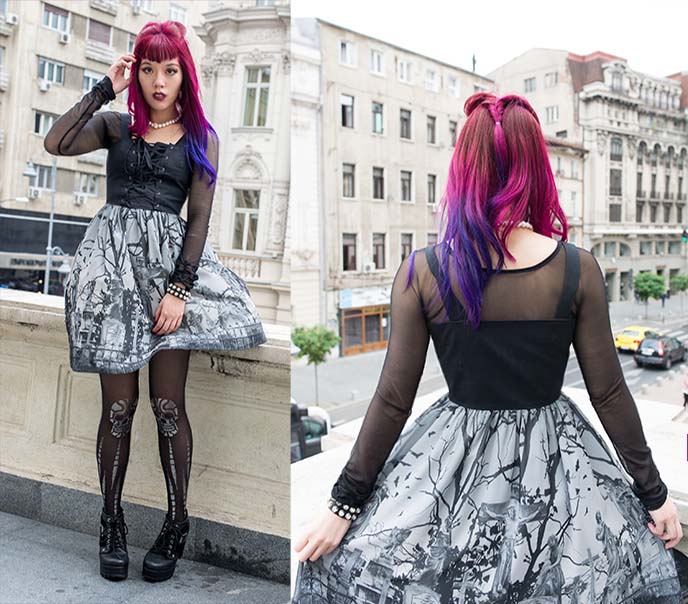
The conference took place at the Novotel Hotel Bucharest, which also hosted my stay. It’s located by Old Town, with a balcony that had this lovely view of the city’s classic architecture.
Hair: My new purple/red/blue ombre haircolor is by Chad Evans at Stratosphere Salon in Vancouver, Canada. He cut my bangs into a vampire V, and did a fishtail braid in the back. So happy with this new hairstyle!
Outfit details: I wore Gal Stern tights with a silver skull pattern, Alex Streeter pearl necklace, Sleevey Wonders sheer sleeves, and a Moi-meme-Moitie graveyard dress (designed by Japan’s Elegant Goth Lolita icon, Mana of the bands Moi-dix-Mois and Malice Mizer).

I spoke at the “The Future of Tourism in Romania” conference, which brought together travel professionals from all around the world. This Eastern European country has modernized and opened up to visitors especially since 2007, when it joined the EU.
The local tourism organizers first shared success stories of tourism in Romania, highlighting the increasing interest of travelers in Sibiu (historical city in Transylvania), Mamaia (beach and resort destination on the Black Sea), Bucovina (scenic historic region on the slopes of the Carpathian mountains) and other areas.

Next, I stepped onto the Experience Romania stage to speak about “Best international practices in tourism and social media.” I was a speaker on this social media panel along with leading travel Instagrammers Altug Galip and Laiza Souza, and Jeanette Ceja who comes from a journalism background.
For about an hour, we answered questions from the audience and shared personal advice on topics related to travel, digital media, press trips, sponsorships and tourism trends. It was fantastic to hear everyone’s perspectives from their various backgrounds, and have a conversation with an audience of hundreds who are passionate about traveling.
I put together a few clips of my Q&A answers during the travel blogger panel. You can see the video above and here.

Many thanks to the Travel Massive Romania volunteers and local businesses for welcoming us bloggers, and showing us the best of Bucharest!
We got to go on walking tours of the city, try various restaurants… I’ll be showing you much more of my explorations soon.

I wore Gal Stern tights, Alex Streeter accessories, Sleevey Wonders under-sleeves and a Moi-meme-moitie dress (the wind gave my skirt and hair a boost!).
More photos of this look at the end of this post, but first…

Is there any better place to wear a vampire cape… than in the land of Dracula?
I transformed into a bat and flew to Bellu Cemetery (part of the Bucharest Urban Adventures “Darkside Tour”). This graveyard, officially known as Șerban Vodă, is the largest and most celebrated one in the city.

Bellu Cemetery was particularly atmospheric during Halloween season, with autumn leaves on the dramatic coffins.
Address and access: Șoseaua Olteniței 3-5, București, Romania. If you’re traveling by subway, get off at the Eroii Revolutiei metro stop (two stops from Universitate Station in Old Town). Entry is free, and the graveyard is open daily from 10 am to 8 pm.

I got to live out my Dracula fantasies in this photoshoot, surrounded by wooden stakes and dark tombstones.
Outfit details: I’m wearing my Black Peace Now designer cape from Japan, and a Moi-même-Moitié dress.

The cemetery is located on a 54-acre plot of land, donated by Baron Barbu Bellu (hence the name). Many of the graves date back to the 1850s, when the Romanian graveyard was founded.
My friends and I enjoyed strolling through the many rows of tombstones, some with interesting and eerie statues.

We came across a memorial to someone named Putin, featuring two Sphinx-women carrying a globe on their backs. (Edit – actually, this actually translates to ‘a little’ and has a spiritism spooky story associated with it… see the first comment at the bottom for the history.) On the right, I half-expected a vampire to rise out of this thorny black coffin!
Many famous Romanians lie beneath the soil including writers, gymnasts and astronomers. Two of the most famous residents are the national poet Mihai Eminescu, and playwright / humorist Ion Luca Caragiale.

Count Dracula may have been imagined by Ireland’s Bram Stoker, but Romanians have long-established legends about the dead rising from the grave. According to the local folklore, these “strigoi” crave fresh blood and can transform into other animals, as well as turn humans into ghouls.
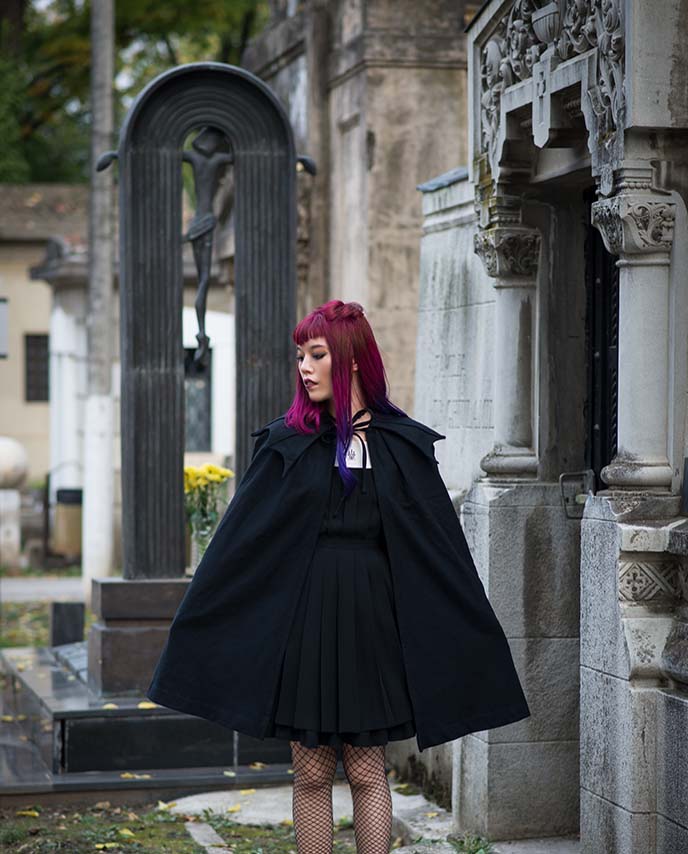
Nosferatu vibes… When you’re standing in Bellu Cemetery, it’s easy to understand why Romanian vampire legends have captured the imagination of millions worldwide.

I love seeing how nature enhances the beauty of the chains and crosses. The leaves add a splash of blood-red to these resting grounds.
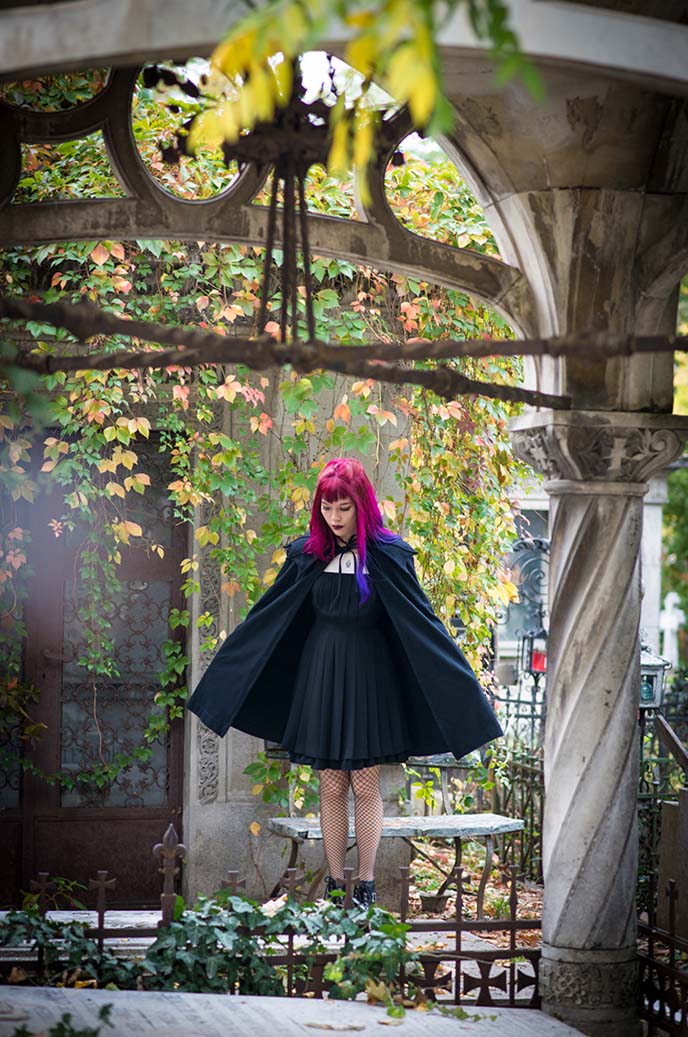
When night falls, who knows what might rise from these coffins?
(Of course, I also visited Bran Castle in Transylvania, associated with Vlad the Impaler… there’s a giant article to come out soon about it.)
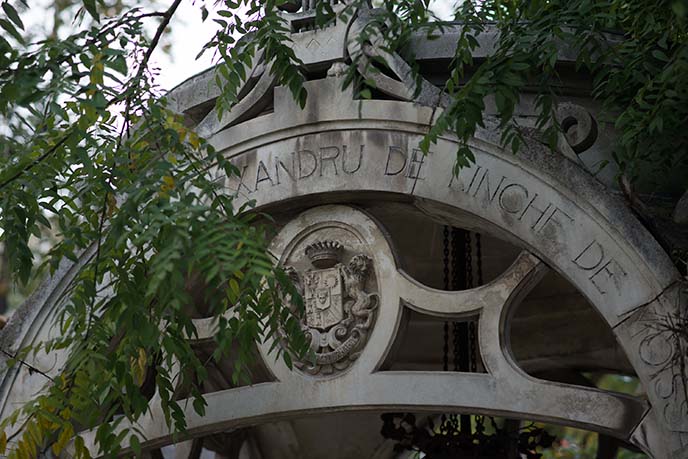
Even if you aren’t captivated by vampire stories, you should spend time wandering in Bellu Cemetery. The local history, art and architecture are fascinating to behold here.
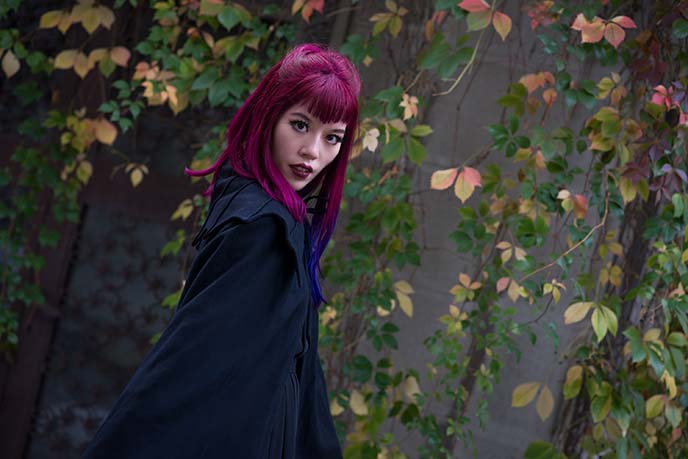
My V-bangs haircut and Black Peace Now cape helped me get into the spooky spirit. Bucharest’s graveyard is truly a Goth dream.
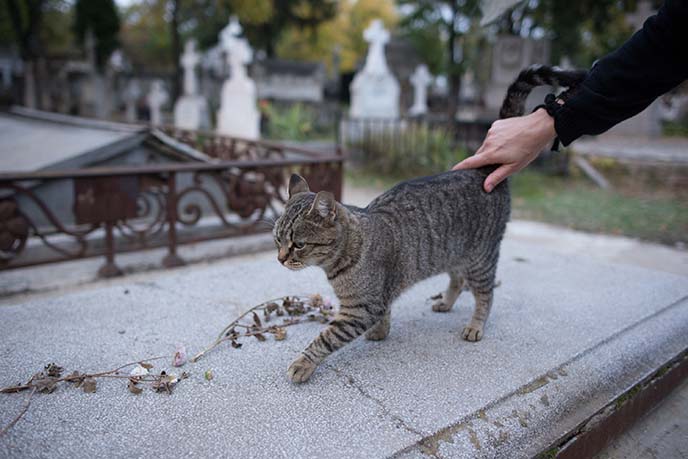
We saw several cats living among the dead. (Dracula’s fellow creatures of the night.)
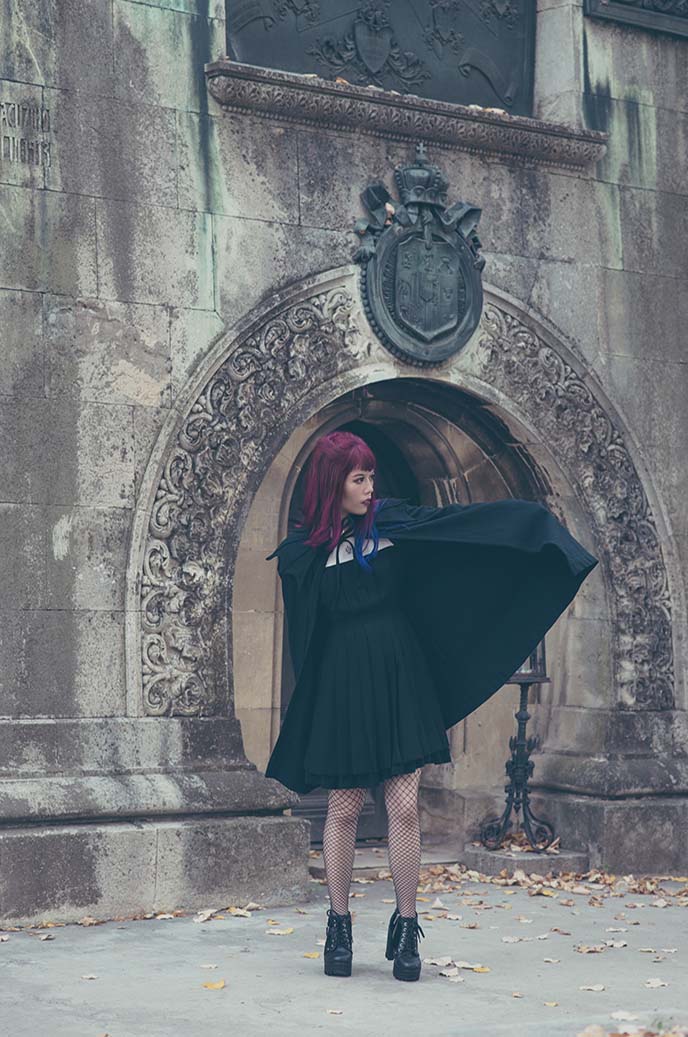
Vampira vibes, in front of one of the largest and most elaborate mausoleums in Bellu graveyard. It belongs to Gheorghe Grigore Cantacuzino, a 19th century Romanian politician and lawyer.

Such a pleasure to tour this necropolis with my Romanian Gothic friends, Beatrice and Alex.

In love with the historic architecture and dark decay of the mausoleums.

Most of the burial ground is Eastern Orthodox, with well-tended graves topped with crucifixes and angel statues.

“Out of what crypt they crawl, I cannot tell / But every night I see the rubbery things / Black, horned, and slender, with membraneous wings / And tails that bear the bifid barb of hell.” – H.P. Lovecraft, “Night-Gaunts.”
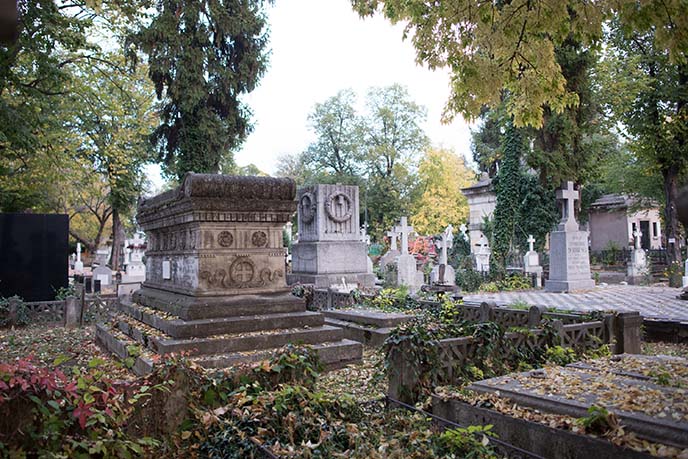
This photospeaks for itself… Bucharest’s Bellu Cemetery is one of the most beautiful I’ve visited.
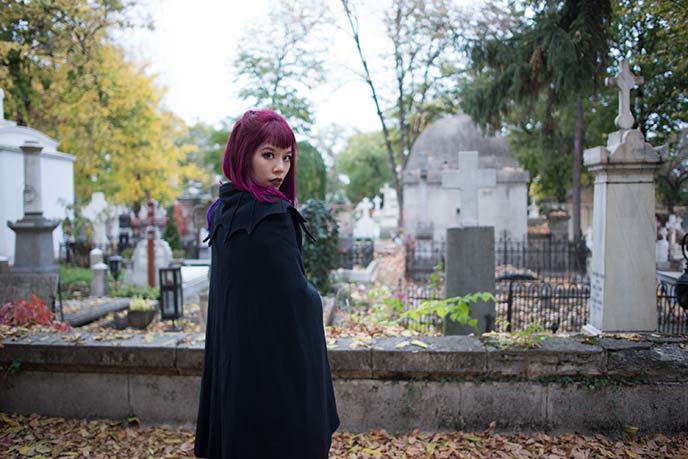
You can come here on your own, or join the Bucharest Urban Adventures Dark Side walking tour. It also takes you to other eerie parts of the city, including a serial killer’s alleyway and bloody buildings from the Communist era.

“To walk with me you must die to your breathing life and be reborn to mine.” – Count Dracula in Bram Stoker’s novel

Bellu Graveyard is tended by citizens, rather than the government. Many locals come here to leave flowers and offerings, and maintain the tombs in good condition.

Although this is a huge plot of land at 54 acres, the graveyard has been filled up over the past century and half. The paths between the rows are narrow, which make you feel close to the dead (or undead?)
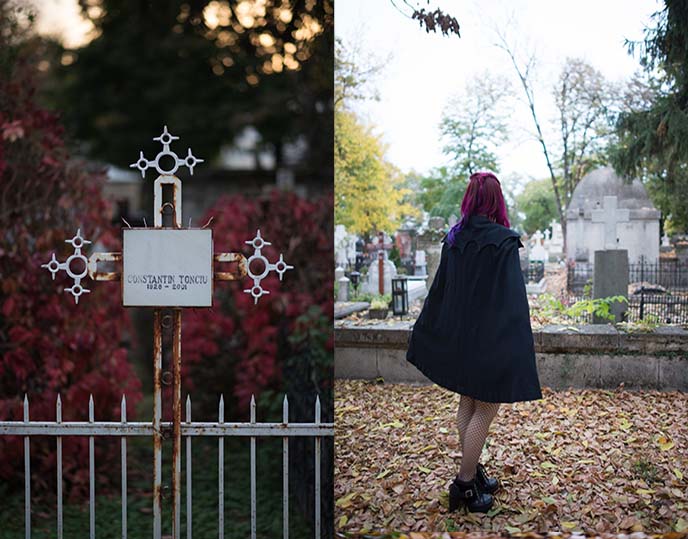
As you can see, Bucharest was everything this Goth girl imagined it to be… and far more.

I’m very grateful to the Experience Bucharest family for bringing me to their hometown, and having me take part in the conference’s 2nd Edition! (Above, with the lovely Anda Maxim who worked hard on the program, along with the other team members.)
Some of the invited bloggers stayed for an extra two weeks, and toured all around the country with Experience Romania. I’ll have to return soon to see more.
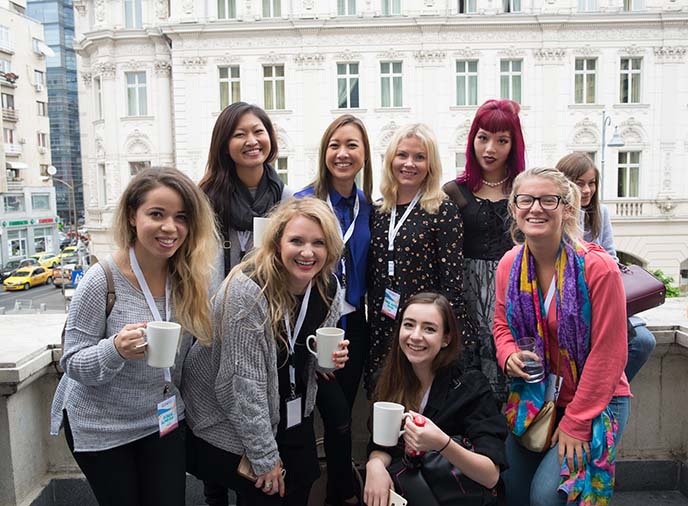
One my favorite parts of Experience Bucharest? Meeting dozens of fabulous travel storytellers, each with a unique niche and medium. (Facebook Live, LGBT, comedy videos, history blogs, desserts, you name it).
We hit it off with our shared love of travel; it’s such a joy to connect with others who walk a similar path. I left feeling inspired, and am sure I’ll meet up with many of these new friends somewhere in the world.

I leave you with some close-ups of my jewelry. My Morbid Debutante white skull and pearls necklace is by Alex Streeter (who created the pentagram Angel Heart ring, most recently worn by Marilyn Manson on the cover of several music magazines).

My vampire nails were bloody perfect for the occasion. Dripping blood, bats, Dracula, fangs, coffins and skulls, rendered by hand in unbelievable detail.
As always, these gel nails are the work of Keiko Matsui at Glam Nail Studio in Vancouver. You can see a close-up of the nail art here on my Instagram, and I’ll post more images soon. (My bracelet cuff is vintage Yohji Yamamoto.)

So thankful to Experience Romania / Bucharest for having me come to give a talk on the social media panel, and capture these stories and photos for you. (All photography by Joey Wong.)
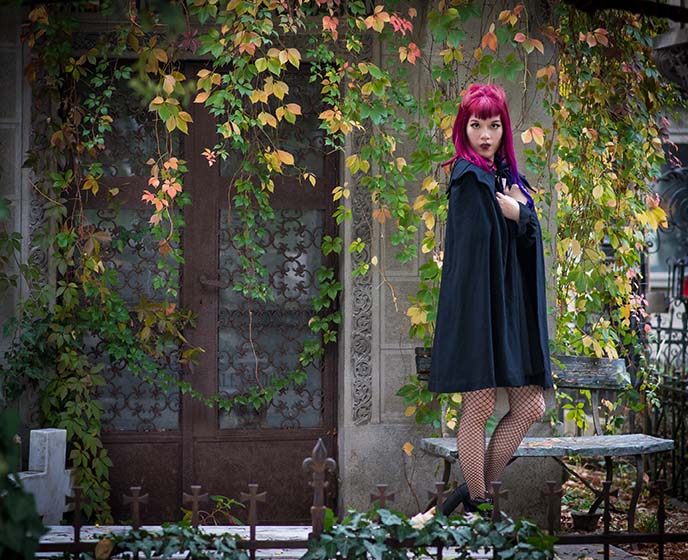
“Listen to them, the children of the night. What music they make!” – Bram Stoker’s “Dracula”
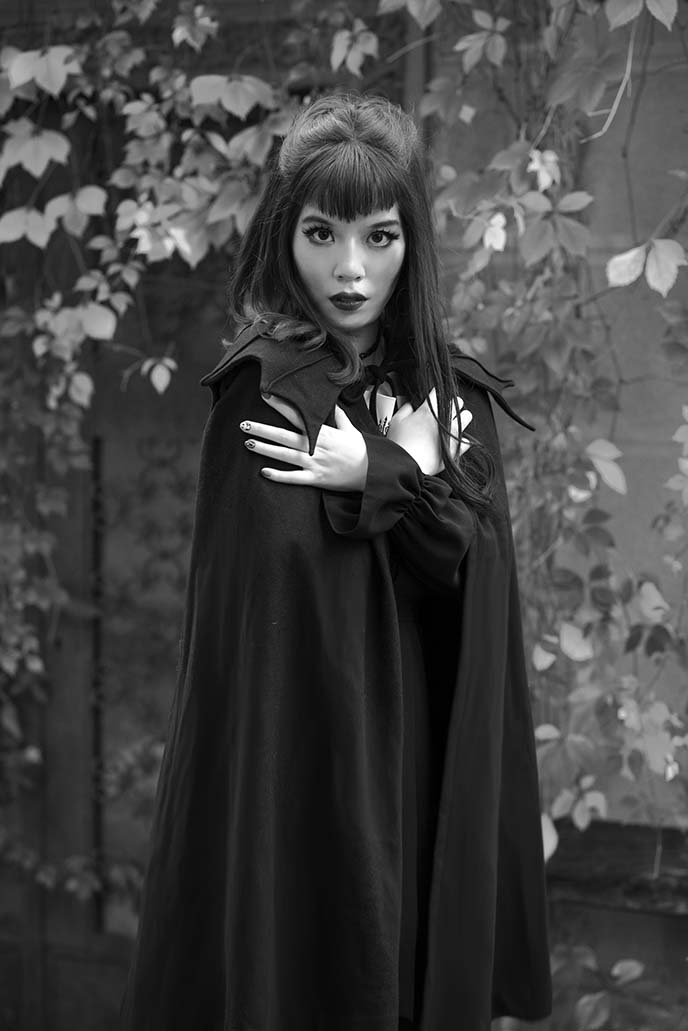
This is only the first bite of Bucharest. Many more travel tales to come, including a visit to Bran Castle, and alternative street art tour.
What are your impressions of Romania so far? Have you ever thought of visiting? If there was a land for Goths… I think it would be here!
SHARE & COMMENT
Osaka, Japan Gothic stores! Satanic Territory occult & witchcraft shop, Japanese tattoos, pentagram fashion.

“Today is enjoy!” Since it’s still spooky season, I thought I’d release an updated guide to the Gothic and underground shops of Osaka, Japan.
The red pentagram hints at the theme of today’s post. We’ll delve into the Kansai Goth, occult and Satanic scene…

… including exclusive photos of Territory, the devilish lair of Taiki-san. Read on for Osaka tattoos, taxidermy and absinthe as well!

I thought I’d include these purikura (sticker machine) photos from Tokyo as well, since there are quite a few devil horns and pentagrams. Doing purikura with friends is a must when you’re in Japan. You’ll wind up with ridiculous sticker images (often with bizarre English) that you can decorate before printing out.
Outfit details: I’m wearing Killstar leggings and a top from Dead Gallery Iceland, by artist Jon Saemunder Audarson.

There are “sticker picture” photobooths around the world, but the most high-tech and bizarre ones are only in Japan. Go to any game center, such as Taito in Shinjuku, and you’ll find a handful or more “purikura” machines to pick from (as well as games galore).

Japanese purikura (short for “print club”) turns you into a big-eyed, stretch-limbed being. You can choose from all sorts of frames and effects, and digitally decorate the photos.
I especially love to do purikura around Halloween, since they release seasonal stickers (like the ghosts and pentagram stars above).

After posing for about six photos, you can choose your favorites and decorate them side-by-side with your friend. There’s a digital pen that you can use to select various borders, stickers, text and effects (such as changing your hair color).

Purikura decorating is an art form — you want to achieve the perfect balance of ridiculous-ness in the image, without cluttering it up! I think Kanae and I did a pretty good job with these ones.

In the old days, you had to use scissors to carefully cut up and divide the purikura prints. Now, you can choose to print out two copies, as well as send the images to your phone or email. What a world we live in!

And now, let’s dive into the Osaka underworld. Most of the alternative / Gothic / underground shops are in the America Mura district — including this self-described lair of Satanism and Witchcraft, Territory.
The entrance cautions you to Beware. Only those with dark souls dare to cross this gate, guarded by skulls and other deathly figures.
On the Territory signboard, you’ll notice the Latin words “Non Serviam,” or “I will not serve”. The phrase is generally attributed to Lucifer, and sums up the powerful spirit of this establishment.

Since 1996, Taiki’s Territory has garnered a devout underground following. Territory is well hidden, and not even many locals know about its existence. Go down to the basement level, and wander around until you find these skeletons and demons.
Address: 2 Chome-8-33 Nishishinsaibashi, Osaka Center Building B1, Chuo Ward, Osaka, Japan.

I visited Territory’s mastermind, Taiki-san, with Dr. John M. Skutlin (cultural anthropologist and Japan specialist, who writes about subculture and tattoos in Japan). He shares Taiki’s story in this special report.
“The founder of Osaka’s Gothic underground event scene, it is said that Taiki gained his Satanic pedigree in 1996 when he visited New York City and studied the dark arts at a certain occult shop. He returned to Japan in the same year and opened his own shop of occult and Satanic antiques and merchandise – Territory.”

“Meeting with Goth and occult luminaries on the scene like Voltaire and Paul Booth, he eventually became something of a regular in the New York’s Goth music scene during his frequent trips from Japan. This experienced helped inspire him to open his own Gothic music bar – the first of its kind in Japan – called Sabbat on Friday the 13th of October 1999.”

“Taiki began organizing Gothic events for the dark underground of Osaka around the turn of the millennium, including parties like Devil’s Christmas and later the long running Black Veil. His gatherings became yearly highlights that drew guests not only from Tokyo and other cities in Japan, but also from abroad. His events have featured major acts in the EBM and dark electro scenes such as Hocico and Combichrist’s Andy LePlegua.”

“While Bar Sabbat is no longer serving alcohol, his Satanic shop Territory is open for business in Osaka’s Shinsaibashi district, and Black Veil draws Goths from the dark corners of Japan three times a year around Walpurgis Eve, Halloween, and New Year’s Eve.”

Taiki-san usually does not permit photography inside his spiritual shop, but made an exception for us. Taiki has a powerful presence, and surrounds himself with dark talismans. When you speak with him, you feel as if you’re in the presence of a wizard.

Territory is not a Halloween kitsch shop. Everything here is of exquisite quality: dark art sourced from around the world, many with frightening backgrounds attached to them.
You can spend hours looking at all the small details within this museum collection (as not all items are for sale).
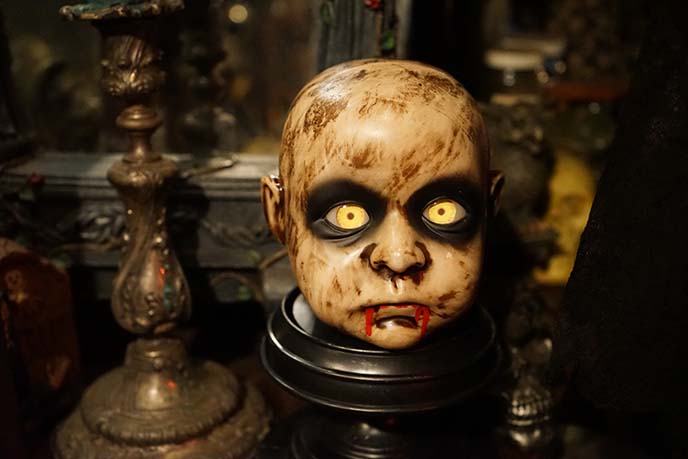
Taiki has a knack for finding works that seem to possess a malevolent spirit. Whether antique or new, these collections convey a sense of death and unease — which Goths like us find fascinating.

Of course, there is plenty of Satanic iconography. The horned one sits next to a Iron Maiden torture device, while a witch baby doll looms in the shadows.

Many items pay homage to Japanese “yōkai,” or monsters and demons in Japanese folklore. However, Taiki has items from around the world, especially relics from Germany and Europe.

In addition to taxidermy and human skulls, Territory carries clothing and home items with the mark of the devil. I picked up a tote bag with the Church of Satan symbol.
You’ll either feel appalled by Taiki’s Territory, or eager to visit (and I hope you’re in the second category!) If you aren’t going to be in Osaka any time soon, you can also order items from his shop online.

In the same building is Fog, an absinthe bar that Taiki-san frequents. My friends and I adore drinking absinthe, and Fog has some of the finest bottles of “green fairy” from around the world.
Fog even carries several of the HR Giger absinthes, named after the Alien art designer (I’m so excited to visit the Giger bar in Gruyeres, Switzerland). We tried the H. R. Giger Wolfsmilch and Absinthe Brevans; the latter is named for Jacques de Brevans, author of a classic French liquor-maker’s manual.

The bartender can help you choose from over 20 kinds of absinthe. He can suggest the best way to drink it (straight, on the rocks, or using the classic water drip over a flaming sugar cube). The bar carries other types of alcohol as well, and does cocktails.
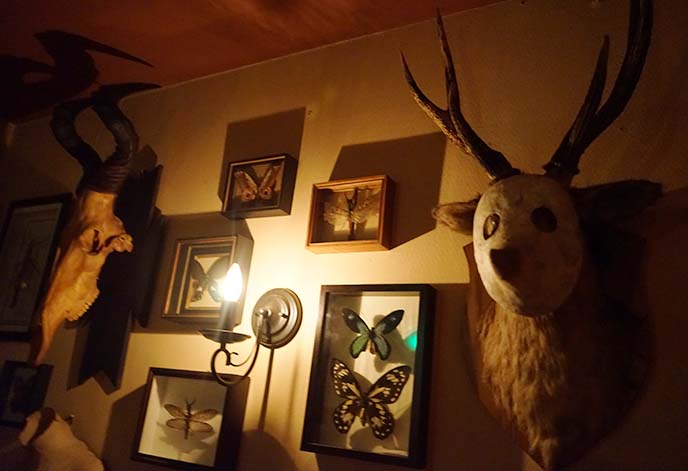
Fog is dimly lit, and until my eyes adjusted, I didn’t realize it was filled with watchful creatures. There was a real owl in one corner, which I thought was stuffed at first.
The walls are mounted with butterflies and insect specimens, as well as creepy deer heads in serial killer masks.

Fog Absinthe Bar’s address is the same as Territory’s; both are in the maze-like lower level of Osaka Center Building.
Address: 2 Chome-8-33 Nishishinsaibashi, basement level, Chuo Ward, Osaka

We also stopped by Bleeding Maria, a special place protected by witches. (Address: 2-18-6 Shinsaibashi, 5th floor – it’s in a Americamura building with an elevator, filled with small shops).
Yukiro and I visited Bleeding Maria many years ago. This time, the witches had flown and we weren’t able to go inside.

I encourage you to drop by this unusual establishment of witchcraft, runes and fortune-telling. The owner, Kaori, speaks English and German very well — so you can visit even if you don’t know Japanese. Perhaps you’ll have a chance to hang out in this spiritual haven, and meet her pet tarantula.

If the words “Painful Pleasures” appeal to you, then you’ve got to visit Babylon. The name hints that this is not just a piercing / body art studio. There are twisted cultural and anthropological treasures to be found within.
Address: 1-16-7 Nishi Shinsaibashi, Osaka
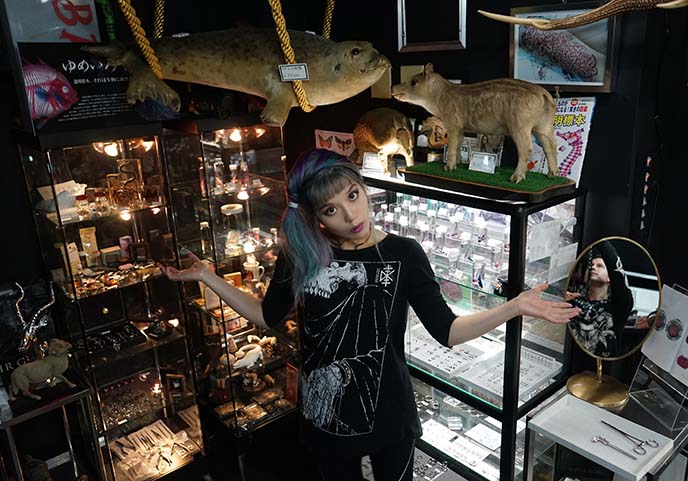
John sets the scene in this report: “Stepping into Babylon Body Art’s Osaka, which started off more than a decade ago as a bar in a different location, one is surrounded by stuffed and mounted animals and various taxidermic specimens. Shelves are filled to capacity with rare and unusual books in both Japanese and English, on subjects ranging from anatomy and zoology to bestiality and methods of execution.”

“The glass cases are full of piercings from brands like Anatometal and Maya Jewelry. On the television, one can expect to find any number of macabre and unusual videos, such as the gruesome scenes of a VHS copy of the infamous Faces of Death shockumentary (directed by Conan LeCilaire, 1978).”

“The owner, Bonzin, admittedly revels in his own self-professed “bad taste.” Covered in tattoos (including a full back piece of the Senju Kannon bodhisattva) and sporting multiple implants (both subdermal and transdermal), he is not only a piercer but also a popular artist and DJ at Goth events, and has organized all of the major suspension performances in Kansai.”

“Bonzin sees his own body as a work of art, explaining he was initially inspired to modify his body in more extreme ways after seeing the decidedly Cronenbergian cyberpunk film Tetsuo: The Iron Man (Tsukamoto Shinya, 1989). He claims to have transformed into the “Iron Man” that he set out to become.”
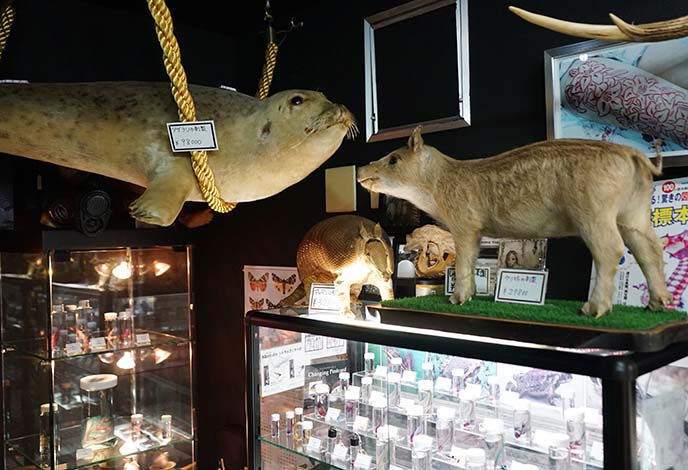
I like how Babylon’s displays have a sense of absurd humor. The seal on a swing looks happy to be bopping noses with a piglet, while an armadillo crouches behind.

This skeleton models a cyber apocalyptic gasmask, wedged between two glass cases.

How kawaii are the stuffed mice, with gems for eyes and black ram horns coming out of their foreheads? Babylon is quite the kingdom of dark delights.

Next, we paid a visit to Horitsuna, the revered tattoo artist at Desperado studio. (Center Bldg 6F, 2-10-29, Nishi-
Horitsuna is self-taught, and specializes not only in Japanese wabori designs, but also tribal and other styles. Above are some design mock-ups featuring devils and daruma.

John has interviewed Horitsuna extensively for his scholarly work, and explains, “He uniquely incorporates Japanese tattoo design elements like gakubori (background designs, such as waves, clouds, or fire, connecting motifs into a larger piece) with more Western design elements, including grotesque and occult themes.”
In a country where tattooing is heavily regulated, Horitsuna is one of Japan’s most prominent tattoo artists and owns two studios. He regularly attends the Hong Kong International Tattoo Convention, and has won awards at conventions in Japan, Thailand, France, and Finland.

All of these underground stores are found in Amerikamura or Ame-Mura (America Village). This remains the best neighborhood in Osaka to see Gothic, Lolita, Punk and alternative street style, including indie boutiques — a sort of equivalent to Harajuku in Tokyo.

To get to this Osaka youth district, take the subway to Shinsaibashi station, and then wander around. The shops change around all the time, and the district is not large, so it’s best to simply spend time here and see what you find.

There’s a great mix of vintage and new street style in Amerika Mura. This time around, I spotted a whole lot of pentagrams / Satanic stars….

This top like Miffy the bunny, with a similar X mouth. How funny to see her with bat wings, inside the star of the devil, yet in soft pastel colors! (I always knew Miffy had an evil side.)
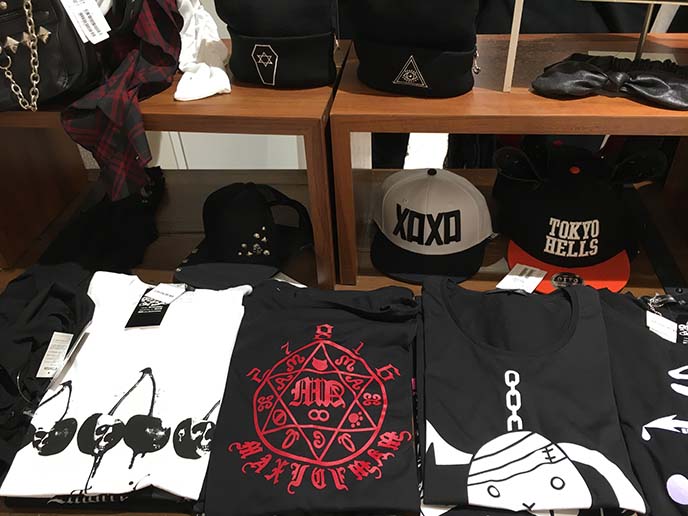
Goth pastel Lolita meets horror Japanese fashion? Osaka’s Big Step department store has all your favorite EGL brands (Alice and the Pirates, Baby the Stars Shine Bright, Kera, Miho Matsuda).

The Magic Amulet collection from Angelic Pretty has several types of pointed stars on its JSK prints.
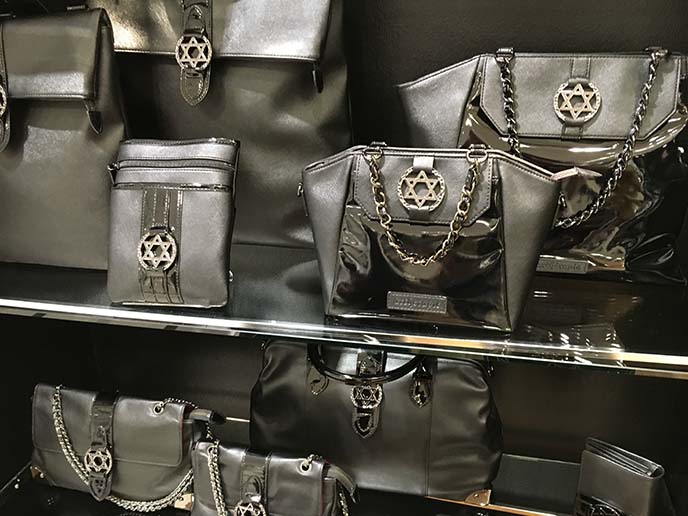
Funny to see the Jewish Star of David… all over Japanese Gothic accessories! Perhaps the designers merely like the look of the six-pointed star.
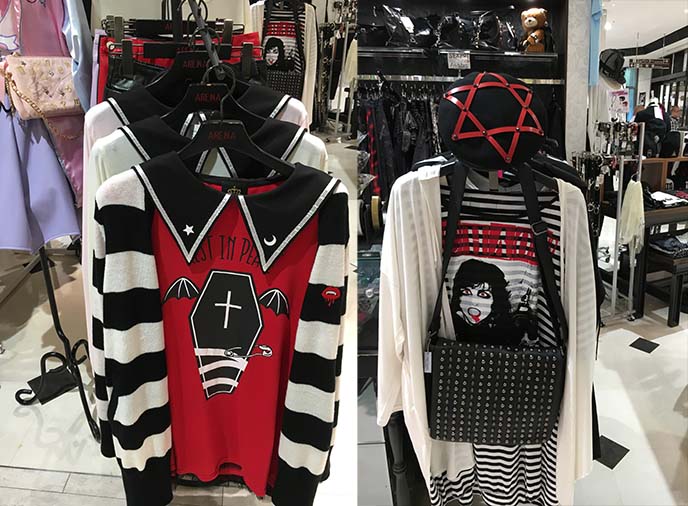
Spooky Goth meets Seinfeld… now that’s a Japanese street style I never thought I’d see!

The devil is everywhere in Shinsaibashi, Osaka. I passed by the 666 store, on the way to Closet Child (the secondhand chain also found in Tokyo).

Theme restaurants abound as well. Here’s the entrance to Alucard, a vampire themed restaurant that is now closed (I guess they were a bit too successful at banishing vampires with wooden stakes). However, you can still visit the Tokyo Vampire cafe.

John introduced me to Cafe Anamune, a medical themed cafe run by locals. I love the laid-back feeling of this little place, which has flasks and zombie nurses lurking around. Order the simple yet lovely Japanese curry, and enjoy the atmosphere.
Anamune Cafe address: 1-8-16 Nakanishi Building 501, Nishishinsaibashi, Osaka.
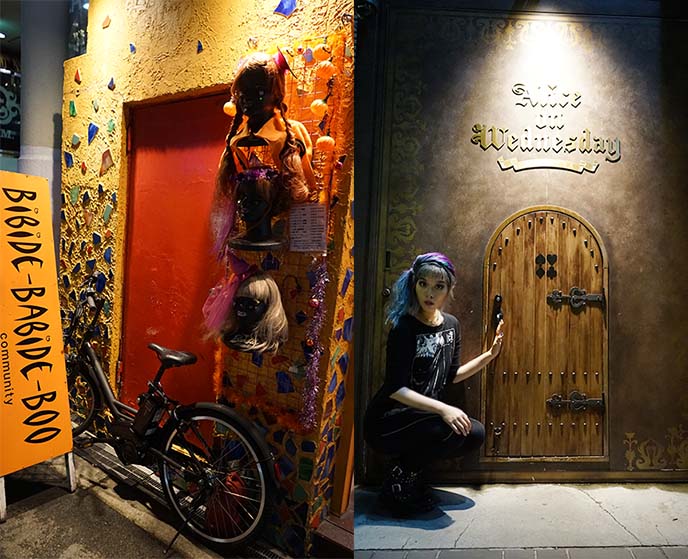
Osaka’s Americamura / Shinsaibashi area is a district filled with funky art, alt culture and inspiration. Such as the Alice on Wednesday shop, which is dedicated to Lewis Carroll’s Alice in Wonderland. If you figure out the correct door and hidden keyholes, you’ll enter a boutique with a Queen of Hearts throne room, Mad Hatter party and more — selling everything from Eat Me candies to clocks.
Alice on Wednesday is found at 2-12-25 Asahi Plaza Shinsaibashi, Osaka

I leave you with this subway poster featuring Miffy the bunny, peeking out passengers! Huge thanks to JR Pass for making this Japan trip a reality.
I was able to travel seamlessly by train, from Tokyo to Osaka and other cities, using an unlimited Japan Rail Pass. Find out more about these rail passes on their site, and in my travel video.

I hope you enjoyed our funny purikura escapades as well! If you’re in Japan, taking “print club” sticker photos is an absolute must.
For more offbeat travel stories from Japan, come browse my Tokyo blog category. There are tips for theme restaurants, underground shops and more, from 2007 to today. Here’s to more Gothic Japanese adventures soon!
 LA CARMINA
LA CARMINA






